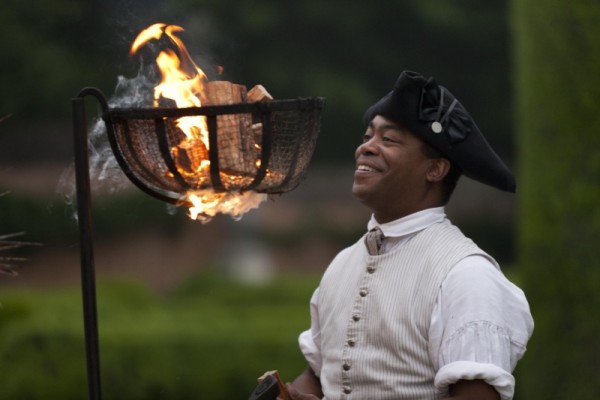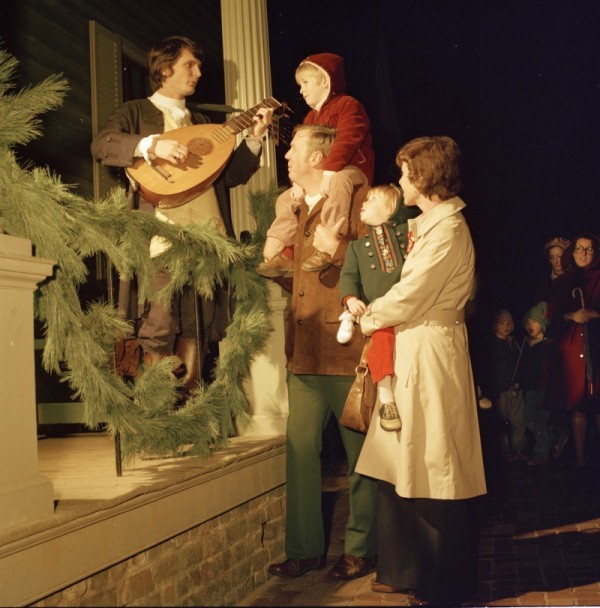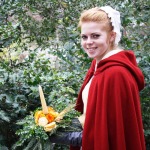
“An illumination in the 18th century was somebody putting a candle in the cupola of the Palace…. Things have gotten brighter and brighter and brighter.” –Bill White
There didn’t used to be fireworks — certainly not the spectacular kind you’ll see on Sunday. In fact, the pyrotechnic display that is such a familiar part of Grand Illumination is a relatively recent innovation, the byproduct of burgeoning crowds for the lighting of Williamsburg.
Carols
Bill White, who started with the Fifes and Drums as a teenager and later organized Grand Illumination for many years, recalls the celebrations of the late 1960s.
“We started at the Capitol. The fife and drum corps marched down the street. There were a bunch of guys from historic trades out in front of us.
“One of them, Ray Townsend, had this great big bullhorn. And he called to the 18th-century residents of every building to turn on their lights, and the lights came on as you went down the street.
“And the whole crowd followed us.
“We went all the way down Duke of Gloucester Street to the Wren Yard (at the College of William & Mary), and they served cider and cookies to the entire audience.”
In those days the crowd was perhaps 500 people. “That was the whole deal, just marching down the street and turning on the lights. There’s just no way you could do anything like that today,” says White.
As the number of Grand Illumination visitors grew, the program had to adjust to make it possible for everyone to enjoy the festivities.

A musician serenades guests at Grand Illumination 1975.
“The next version was a relay because you couldn’t march the whole crowd any longer,” says White.
It began with the firing of cannons at the Magazine. This started a chain reaction in two directions, one across Palace Green to the Governor’s Palace, another down Duke of Gloucester Street all the way to the Capitol.
Members of the militia fired their muskets, members of the Fifes and Drums played and entertainments began.
“They put entertainment on porches up and down the street, and people just walked the street, looked at the lights and the Christmas decorations,” White recalls.
“Our post was on the Geddy porch. They lit cressets there and we stood up on the porch and sang and it was a big kind of mumming party.”
Eventually, even that got too big, although similar illuminations are enacted in slices of the city on many December afternoons.
“That’s when they came up with the fireworks,” says White. “But I’m not sure where they expand to next.”
Cressets
“People say the cressets smell like Christmas,” say journeyman silversmith Preston Jones. The raised iron baskets filled with burning fatwood dot the Revolutionary City in the winter season, lighting the way for visitors and adding to the festive setting.
“For Grand Illumination,” says Jones, “we try to light the whole street with the cressets, so we have about 90 fire baskets. They’re festive lighting.”
Jones has worked at Colonial Williamsburg for nearly 40 years, and for most of that time has helped organize the cresset teams during Grand Illumination. “I can’t remember when I first started that but now I supervise the setting up and taking down of the cressets, making sure the fires are there and people are where they’re supposed to be.”
“People ask: ‘Did they do this in the 18th century?’ Probably not to this extent,” says Jones. “They would only use something like cressets if there was a need—for a gathering, to mount a carriage, to get down the street. They wouldn’t light them just to light them.”
Nighttime was different in the 18th century, he says. “They didn’t travel much at night. They were afraid of the dark.” Illuminations might make winter nights a little shorter, but the darkness was much more forbidding than today.
“Cressets go back to Roman times. It’s like you’d see in the movies, with the torches or a basket, with something burning in it. They’re basically so you don’t walk into walls,” he says.
As for that aroma, it comes from the pinewood. “When the pine tree or any tree dies it tries to save itself, so the sap goes to the heart of the tree,” says Jones. “With the long-leaf yellow pine, which is a great tree to have, that takes 75 to 100 years.”
The process makes the pine waterproof and termite-proof—and very flammable.
“We get ours from a wood supply company,” says Jones. “They sell it to us in chunks, and we chop it up. The smaller it is the faster it burns up. It burns very bright and hot.”
And with each cresset location supplied with about 100 pounds of wood, more than four tons of pine can be expected to burn during Grand Illumination.
Crowds
Safety concerns have long been the purview of Danny McDaniel, Colonial Williamsburg’s director of security. This year marks his 40th Grand Illumination.
In his early years on the job, “it was mainly a coordination issue to get all the buildings turned on at once.” But as the day’s popularity grew, “we had to spread it out because it had gotten to the point where we were absolutely shoulder to shoulder in key areas. It wasn’t a very good guest experience having everyone packed in like that.”
Grand Illumination is “a lot more challenging than the 4th of July because it’s a bigger crowd. Always has been.” A cold rain reduced the size of the crowd 2013 after a record crowd the year before, “quite possibly close to 50,000, according to McDaniel.
Dusk falls as visitors wait on Palace Green for the Grand Illumination Fireworks at the start of the Christmas Season.
Security has grown from 10 or 12 security officers to a force of about 75 that includes the Williamsburg Police and Fire Departments as well as Virginia state police. A thick binder contains a detailed instant action plan to deal with all contingencies. They’re proud of their safety track record at the event and they learn something in each successive year.
“We had a scare once in front of Bruton Parish Church at the height of the program, a pregnant woman who suddenly decided maybe she was going to have her kid. She didn’t. But that led us to think about how we were going to find people in the crowd. So about 10 years ago we went to distinctive-colored light sticks. Everybody has one of those and if they have an incident they stay with the person and raise it just like the statue of liberty.”
“We’ve got bike officers—police, fire, and security—that’s really the only way to get around in that crowd. It’s kind of a low-tech way to do it, but it works.”
McDaniel promises not to enjoy Grand Illumination. “For me it’s the most stressful day of the year,” he says. And the next morning, the team will start revising the plan for next year.

This is incredible! I always enjoy hearing about the history of traditions at Colonial Williamsburg. It is such an inspiring and emotional ceremony and it is so interesting to hear the CW staff’s side of the tradition.
Lolita C. Payton says
Thank you so very much for the live feed of the Grand Illumination! Planning now to be there in 2016 to enjoy all of the festivities.
Roy Long says
Great show, we will be down in two weeks for Christmas shopping.
Roy Long says
We went for the last two years, the best fireworks that I have ever seen! We can’t get away this year, so an internet show is something special!
I’m so excited about the possibility of seeing the Grand Illumination, here in southern MN. Seeing what the weather is like at CW right now, I wished I could send you our weather we are having today, (Saturday), cold by your standards, but otherwise perfect.